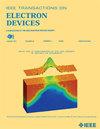Performance and Reliability Tradeoffs of Power Amplifier Cells Using High-Performance and Medium Breakdown SiGe HBTs
IF 2.9
2区 工程技术
Q2 ENGINEERING, ELECTRICAL & ELECTRONIC
引用次数: 0
Abstract
In this work, the reliability and performance characteristics of silicon–germanium heterojunction bipolar transistor (SiGe HBT) cascode amplifier cells are investigated. In particular, this study investigates the tradeoffs of using transistors scaled for maximum performance or for increased breakdown voltage in the common-base stage of the cascode. The cascode structures are investigated for their dc operating limits, as well as their small- and large-signal performance, and their electrical reliability. Simulations and measurements are performed to determine how to minimize the performance tradeoffs and maximize the reliability improvement of each device type. It is shown that the difference in peak unity cutoff frequency (求助全文
约1分钟内获得全文
求助全文
来源期刊

IEEE Transactions on Electron Devices
工程技术-工程:电子与电气
CiteScore
5.80
自引率
16.10%
发文量
937
审稿时长
3.8 months
期刊介绍:
IEEE Transactions on Electron Devices publishes original and significant contributions relating to the theory, modeling, design, performance and reliability of electron and ion integrated circuit devices and interconnects, involving insulators, metals, organic materials, micro-plasmas, semiconductors, quantum-effect structures, vacuum devices, and emerging materials with applications in bioelectronics, biomedical electronics, computation, communications, displays, microelectromechanics, imaging, micro-actuators, nanoelectronics, optoelectronics, photovoltaics, power ICs and micro-sensors. Tutorial and review papers on these subjects are also published and occasional special issues appear to present a collection of papers which treat particular areas in more depth and breadth.
 求助内容:
求助内容: 应助结果提醒方式:
应助结果提醒方式:


